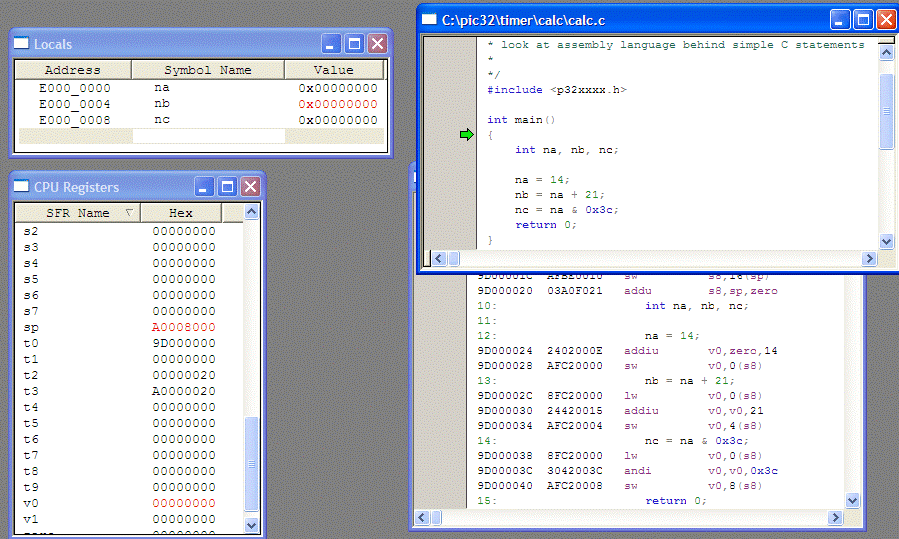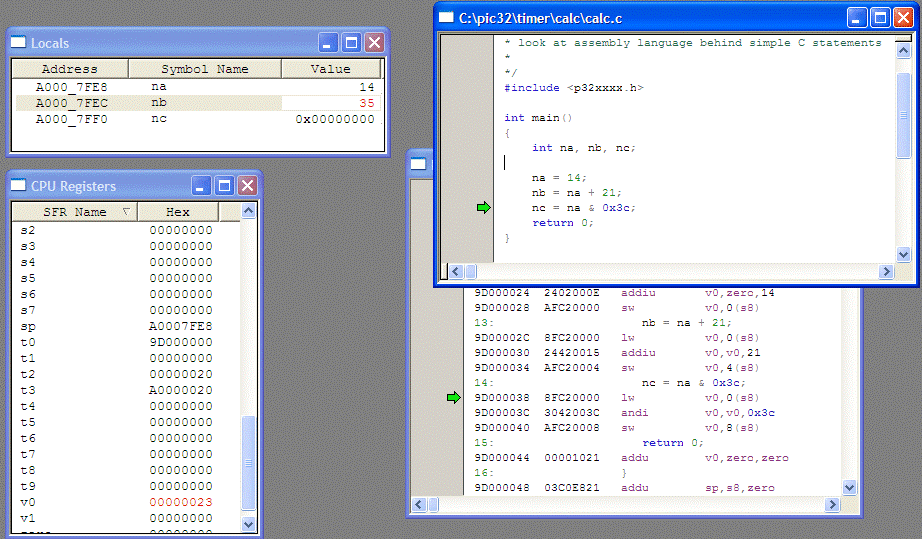
The C32 compiler produces object files which are then linked into executable files. There is debug information in the executable file that allows the user to associate the binary machine instructions with the original source code. This process of reverse engineering is called disassembly. You may examine the disassembled source by selecting View -- Disassembly Listing from the top menu. You may also wish to select View -- CPU Registers and View -- Locals as well.
If you have set the simulator as described in PC32 Simulator, pressing the Reset button on the toolbar (or selecting Debugger -- Reset -- Processor Reset (F6) from the top menu) will position the cursor at the start of the main function, as shown below. Note that the CPU Registers are arranged alphabetically rather than numerically. The association between register numbers and register names is described in registers.

The information in each of the windows above may be saved by right clicking on the window and selecting the Output to File menu item. The disassembly listing, for example, is reproduced below.
You may wish to step through the program and observe the changes in the values of local variables and CPU registers. Press the Step Into button on the Debugger toolbar or select Debugger -- Step Into (F7) from the top menu. The window below shows the result after several steps.

You can choose what format information is displayed by right-clicking in a window to bring up the context-sensitive menu for that window. We changed the display format for na and nb in the Locals window from hex to decimal.
The motivation for this example is to explore how a C program allocates variables, assigns values to those variables, and performs simple arithmetic and logic operations. We show how the program decodes the diassembly information and interpret the operations being performed.
C Source
Disassembly Listing
Hand Disassembly
Interpretation
Download C source from: calc.zip
01: /* calc.c
02: *
03: * look at assembly language behind simple C statements
04: *
05: */
06: #include <p32xxxx.h>
07:
08: int main()
09: {
10: int na, nb, nc;
11:
12: na = 14;
13: nb = na + 21;
14: nc = na & 0x3c;
15: return 0;
16: }
--- C:\pic32\timer\calc\calc.c ----------------------------------------------------------------- 1: /* calc.c 2: * 3: * look at assembly language behind simple C statements 4: * 5: */ 6: #include7: 8: int main() 9: { 9D000018 27BDFFE8 addiu sp,sp,-24 9D00001C AFBE0010 sw s8,16(sp) 9D000020 03A0F021 addu s8,sp,zero 10: int na, nb, nc; 11: 12: na = 14; 9D000024 2402000E addiu v0,zero,14 9D000028 AFC20000 sw v0,0(s8) 13: nb = na + 21; 9D00002C 8FC20000 lw v0,0(s8) 9D000030 24420015 addiu v0,v0,21 9D000034 AFC20004 sw v0,4(s8) 14: nc = na & 0x3c; 9D000038 8FC20000 lw v0,0(s8) 9D00003C 3042003C andi v0,v0,0x3c 9D000040 AFC20008 sw v0,8(s8) 15: return 0; 9D000044 00001021 addu v0,zero,zero 16: } 9D000048 03C0E821 addu sp,s8,zero 9D00004C 8FBE0010 lw s8,16(sp) 9D000050 27BD0018 addiu sp,sp,24 9D000054 03E00008 jr ra 9D000058 00000000 nop
The disassembly window decodes the machine language (binary instructions) into the instruction mnemonic and the associated argments (registers or immediate operands).
For example the first three instructions are:
| address | machine instruction | mnemonic | arguments |
|---|---|---|---|
| 9D000018 | 27BDFFE8 | addiu | sp,sp,-24 |
| 9D00001C | AFBE0010 | sw | s8,16(sp) |
| 9D000020 | 03A0F021 | addu | s8,sp,zero |
The first two instructions are immediate (I-Format) instructions which have the following fields:
| op | rs | rt | operand/offset |
|---|---|---|---|
| 31:26 | 25:21 | 20:16 | 15:0 |
| 6 bits | 5 bits | 5 bits | 16 bits |
| Opcode | Source or base | Destination or data | immediate operand
or address offset |
Using this information, we can decode the first two instructions:
| instruction | op | rs | rt | operand |
|---|---|---|---|---|
| 0x27BDFFE8 | 0010 0111 11101 1101 | 0xFFE8 | ||
| 00 1001 | 1 1101 | 1 1101 | | |
| 0x09 | r29 (sp) | r29 (sp) | -2410 | |
| addiu sp,sp,-24 | ||||
| 0xAFBE0010 | 1010 1111 1011 1110 | 0x0010 | ||
| 10 1011 | 1 1101 | 1 1110 | ||
| 0x2B | r29 (sp) | r30 (s8) | 1610 | |
| sw s8,16(sp) | ||||
The third instruction is a register or R-Format instruction, which has the following fields
| op | rs | rt | rd | sh | fn |
|---|---|---|---|---|---|
| 31:26 | 25:21 | 20:16 | 15:11 | 10:6 | 5:0 |
| 6 bits | 5 bits | 5 bits | 5 bits | 5 bits | 6 bits |
| Opcode | Source 1 | Source 2 | Destination register | Shift amount | Opcode extension |
We can decode the third instruction as follows:
| instruction | op | rs | rt | rd | sh | fn |
|---|---|---|---|---|---|---|
| 0x03A0F021 | 0000 0011 1010 0000 1111 0000 0010 0001 | |||||
| 00 0000 | 1 1101 | 0 0000 | 1 1110 | 0 0000 | 10 0001 | |
| 0x00 | r29 (sp) | r0 (zero) | r30 (s8) | 0x00 | 0x21 | |
| add s8,sp,zero | ||||||
Once we have the assembly language equivalent to the C source we can infer the register transfer operations that are being performed and make some observations about what is happening.
8: int main()
9: {
addiu sp,sp,-24 sp <= sp - 24 Allocate 24 bytes on stack
sw s8,16(sp) M[s8+16] <= s8 save s8
addu s8,sp,zero s8 <= sp This is how MIPS does a simple register transfer
10: int na, nb, nc;
11:
12: na = 14;
addiu v0,zero,14 v0 <= 14 This is how MIPS initializes a register
sw v0,0(s8) M[s8+0] <= v0
13: nb = na + 21;
lw v0,0(s8) v0 <= na
addiu v0,v0,21 v0 <= na + 21
sw v0,4(s8) M[s8+4] <= v0
14: nc = na & 0x3c;
lw v0,0(s8) v0 <= na
andi v0,v0,0x3c v0 <= v0 & 0x3c
sw v0,8(s8) M[s8+8] <= v0
15: return 0;
addu v0,zero,zero v0 <= zero Set the return value
16: }
addu sp,s8,zero sp <= s8 restore stack pointer
lw s8,16(sp) s8 <= M[sp+16] restore s8
addiu sp,sp,24 sp <= sp + 24 deallocate memory on stack
jr ra return from function
nop
We observe that the compiler assigned the following local variables
| address | variable |
|---|---|
| sp+0 | na |
| sp+4 | nb |
| sp+8 | nc |
Maintained by John Loomis, updated Sun Aug 03 21:38:03 2008